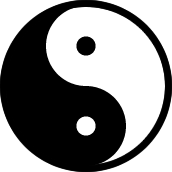Shen and its role in the practice of Taijiwuxigong (excerpt)
SHEN AND ITS ROLE IN THE PRACTICE OF TAIJIWUXIGONG
In the Chinese language the word Shen is used to denote the most essential, most refined form of human substance. It refers to the divine or numinous within us. It is usually translated as ‘mind’ or ‘spirit’. In the broadest sense of the word, Shen encompasses everything that plays a part in the emotional, mental and spiritual life of the human being. In the narrow sense, Shen refers to the emotional-mental-spiritual complex that belongs to and is related to the Heart. Aspects of Shen are the ethereal soul (Hun), the corporeal soul (Po), the intellect (Yi), willpower, and mind (Shen) itself.
In the context of Taijiwuxigong, Shen can be understood as the combination of the opposing qualities of awareness and intention.
When we speak of awareness we are referring to something that permeates our consciousness with understanding or experience. What is perceived may be a thought, a memory, an emotion, a feeling or a sensory perception.
Intention is directed at something we want, or want to achieve, and involves focusing, mentally taking something in, or imagining or creating a certain feeling or emotion.
While awareness is passive in the sense that it only perceives, intention is active.
Although awareness and intention are presented here as opposites, they are often indistinguishable; because they produce and complement one another they often blend into each other. Intention arises in awareness and awareness brings intention into being.
While awareness is continuous, intention constantly emerges and dissolves.
Awareness is the continuum in which thoughts, memories, emotions, feelings or sensory perceptions arise and are noticed, together with the impact these have on the body, qi and anything else.
Dr. Shen Hongxun rarely used the Chinese word Shen or the English word ‘awareness’, and instead of ‘intention’ he tended to use the term ‘mental force’.
It is because mental force arises from the development of awareness and intention, that I am focusing on these concepts.
Intention either stems from and is driven by sense perceptions, or else it arises independently. When intention arises independently, it motivates clear and refined perception: this is the context in which mental force is developed. As this force increases, awareness becomes clearer and more refined and intention more unambiguous and pronounced.
AWARENESS
Our use of the word awareness can be divided into two categories which we might term ‘self-existing awareness’ and ‘conscious awareness’, a distinction not usually made. Self-existing awareness is effortless whereas conscious awareness involves effort.
SELF-EXISTING AWARENESS
The word that probably comes closest to self-existing awareness is ‘wakefulness’. When it is naked – that is, when there is no conceptualization, interpretation or judgment – there is no duality between the perceiver and the perceived, there is only seeing, hearing, smelling, feeling and tasting.
In self-existing awareness there is no notion of a me. In its absence there is only beingness.
CONSCIOUS AWARENESS
When a me appears in consciousness; consciousness seems to get a centre. With the arising of a me, duality arises. Some experiences we prefer and others we try to avoid. If we follow our preferences and dislikes in an unbridled way, we give in to our tendencies and instincts. And if we want these impulses to be regulated, we motivate ourselves to be consciously aware. We develop this subtle form of attention to determine what we want to experience, the size of the awareness-field and the degree of mental relaxation. If there is no friction, they are determined almost effortlessly by an almost transparent me.
 Info over aanmelding
Info over aanmelding
 Facebook
Facebook